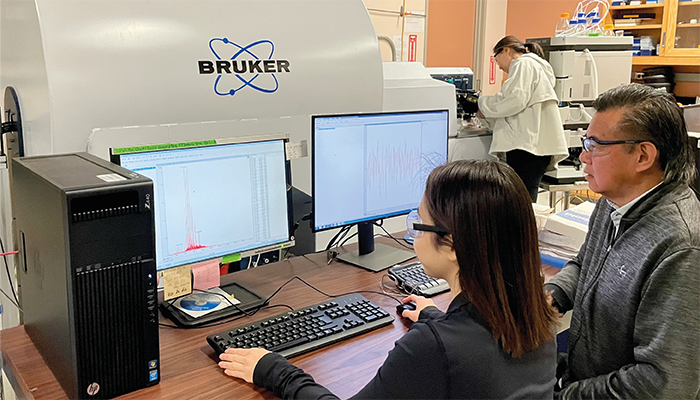The term “native MS” was coined in 2004 by Albert Heck, but many researchers have performed electrospray ionization (ESI) MS experiments to detect interactions between non-covalently bound molecular partners since it was first demonstrated in 1991 by a group at Cornell University. Indeed, I’ve been developing and applying native MS for over 30 years.
Since John Fenn developed ESI in the late 1980s, several groups showed interest in the possibility of directly measuring protein-ligand and protein-protein interactions through MS. While working with Dick Smith at the Pacific Northwest National Laboratory, we demonstrated that ESI-MS could probe the binding specificity of protein-ligand interactions. Then, while working at Parke-Davis Pharmaceuticals (which eventually became Pfizer), we applied native MS to measure the binding affinities for potential drug compounds interacting with protein targets. Native MS soon became a useful tool for screening small molecules from compound libraries for further high-resolution X-ray crystallography or NMR studies for drug discovery purposes.
With improved sensitivity and increased mass range, native MS can now address larger protein complexes – up to the megadalton range. However, we already know the potential of this technique for measuring the size, heterogeneity, and binding affinities of large protein complexes – they were already established in the 1990s!

In our lab, we’ve looked at answering relatively simple questions, such as: “Does this protein bind to another protein? How many proteins does it bind? Are there other molecules bound to the protein?” All of which we were able to address by a molecular mass measurement of the complex – native MS. For example, we found that a protein complex is a hexamer, not a trimer or tetramer as previously suggested in earlier models or lower resolution techniques, such as size exclusion chromatography or centrifugation. Detecting small molecules bound to the protein, such as lipids, metal ions, and ATP, is straightforward because the MS mass measurement provides the information directly.
In addition, drug binding studies are quite amenable by native MS. Though not reaching capacity levels of screening platforms in industry and academic screening labs, the throughput of the measurements can be moderately high with automation to identify molecular scaffolds by screening targeted or focused compound libraries for further drug development. While working at Pfizer, we used native MS to detect co-binding of a potential drug and an ATP molecule to a protein kinase, which was a target for a potential cancer treatment. This revealed that the drug was binding in a distinct pocket away from the ATP-binding site, showcasing a unique mechanism of action for a potential cancer drug. This highlights one of the benefits of native MS – the capacity to provide specific molecular details of biomolecular interactions without relying on time-consuming and high sample-consuming methods, such as crystallography, NMR, and electron microscopy.
More broadly, native MS has been a useful tool for research groups in labs and institutions, and for some fields it is an essential method. Membrane protein structural biology has opened up with the addition of native MS, with Carol Robinson’s research group at Oxford paving the way forward. Structure determination of membrane proteins is challenging due to their hydrophobic nature, requiring specialized solubilization methods, such as detergent-based micelles and nanodiscs. Because membrane proteins are potential targets in drug discovery, native MS provides binding and structural details, including the role of specific lipids in stabilization.
The megadalton range of native MS has also expanded to measure viral assemblies, including pathogenic viruses and those used in gene therapy and drug delivery. In the 1990s, detecting a relatively simple protein like the intact 64 kDa human hemoglobin was a challenge. But now, native MS allows labs to measure hemoglobin from a single red blood cell to determine the molecular mass of jumbo-sized molecules, like a virus. It’s a remarkable advancement!
However, the disadvantage is that you need a high-performance mass spectrometer – and they aren’t cheap. They also aren’t easy to automate for native MS and not every sample behaves in the same way. Some expertise is required to run these machines, but, as the field matures, I hope that these issues will disappear. We need to democratize native MS to progress.

Image credits: Joseph Loo
A biochemical no brainer?
A reliable technique that provides knowledge on whether or not molecule-X binds to Y-numbers of Z-molecules should be present in every biochemical analysis facility. And if native MS can routinely determine binding affinities, who wouldn’t want it in their lab?
Currently, there’s a demand in large institutions to establish or enlarge structural biology labs to include as many cryoelectron microscopy (cryoEM) platforms as they can afford. CryoEM and cryo-electron tomography (cryoET) are game changers in the structural biology domain because of their unprecedented capability for obtaining atomic level structures of large macromolecular machines.
Native MS compliments cryoEM – without replacing it, of course – by assisting with screening sample preparations before they move onto subsequent labor-intensive cryoEM experiments. It could be used to assign features in cryoEM-derived structures that were unanticipated, such as a post-translational modification. Native MS could also identify additional proteins or small molecule ligands that bound to the complex. Relative to the cost of a high-resolution cryo-electron microscope, an additional native MS instrument is a mere drop-in-the-bucket. CryoEM vendors should make mass spectrometers an accessory within purchase orders.
Additionally, a few labs are making efforts to essentially physically marry native MS and cryoEM. Protein ions going through a mass spectrometer can be filtered so that only those of interest are deposited onto EM grids for subsequent high-resolution structure determination. This technique, called soft landing, could well be the future marriage of cryoEM and native MS.
In my view, native MS will continue to expand its applicability across different areas of research as mass spec technology improves in sensitivity, accuracy, resolving power, and so on. However, there are other barriers to native MS adoption; for example, sample prep has been a consistent issue for novices in particular. When combined with ESI, native MS doesn’t tolerate the usual buffers and salts that most biochemical labs use – and each protein system can behave differently. This is where additional education on sample prep practices would be useful – as highlighted in Nature Methods in 2019 (1).
Another challenge for biopharma companies is a relative lack of automation in today’s most common native MS platform, which uses nanoESI needles or emitters and can result in low sample throughputs. The Wysocki Lab at Ohio State University developed a relatively simple strategy that combine sample desalting via a mini-size exclusion chromatography column with a slightly higher sample injection flow rate compared with nanoESI. It can be automated in principle.
I feel that the relatively high price tag for a mass spectrometer suited to native MS experiments is particularly challenging for academic labs. Why can’t vendors design a relatively simple-to-operate, low cost instrument with moderate resolving power and mass-to-charge range that addresses most routine native MS applications? More advanced labs with sophisticated instruments and expertise can manage heroic instruments that demand higher-end resources.
My advice? Talk to the experts. Visit their labs and watch them perform a native MS measurement. It’s hard to replace seeing an experiment performed in person. Even though I no longer have the time to conduct experiments with my own hands, I watch my students in the lab and visit other institutions' labs – especially if I’m interested in a new type of mass spectrometer.
Attending mass spec conferences that include native MS talks – for example, the American Society for Mass Spectrometry (ASMS) meeting are also highly beneficial. Students can also find summer classes on mass spec that involve native MS. Simply approach an expert and put your questions forward. They won’t bite (at least most of them won’t, I think).
Time to go native?
I believe that every biochemistry core facility should have a native MS instrument. It should be easy for a student researcher to use and achieve a reliable result in a matter of minutes. Currently, we have walk-up matrix-assisted laser desorption/ionization (MALDI)-MS instruments. And of course GC-MS and LC-MS instruments are present in most chemistry facilities.
I also hope that native MS will be used to complement high resolution structural biology experiments. It’s already becoming indispensable for membrane protein research, such as for G-protein-coupled receptors (GPCRs). The application of native MS for characterizing viruses is already filling a role in drug research and discovery, and pharma companies have been using native MS for protein-ligand and drug binding measurements. No doubt it could be further integrated with future automation. The combination of native MS with on-line ion mobility offers enhanced insight into protein folding, conformations, and the impact of ligand binding. Given that biological processes rely on molecular interactions, native MS can serve as a go-to tool, providing direct readouts of these processes.
From our side, for the past 15 years, we’ve been developing methods to integrate top-down MS (which directly fragments gas phase biomolecules to obtain protein sequence information) with native MS. This integration allows us to obtain proteoform information for detected protein complexes. For protein-ligand complexes, native top-down MS helps identify specific binding sites on the protein structure. We’re applying this strategy to map binding sites of compounds that inhibit the formation of protein aggregates, such as amyloid oligomers, found in neurodegenerative diseases. Native MS is also used for measuring lipid binding in membrane proteins, and we’re currently developing methods to map these binding sites on the protein scaffold.
Additionally, we’re trying to solve the structure of a protein repair enzyme associated with certain human diseases. Although obtaining a high-resolution structure has been challenging, we hope that our native top-down MS measurements can aid the development of an initial structure model. If anyone is interested in using native MS to identify tens-to-hundreds of protein complexes as a single proteomics experiment, we’ll be presenting at the ASMS conference this June in Anaheim, CA.
Joseph Loo is Professor of Chemistry and Biochemistry at University of California, USA
References
- DP Donnelly et al., Nat Methods, 16 (2019). DOI: 10.1038/s41592-019-0457-0.




